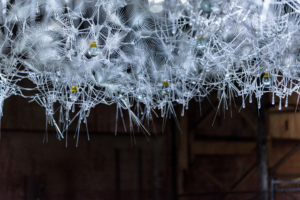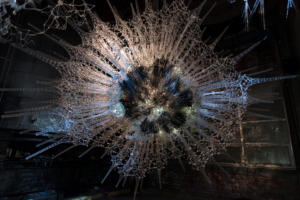 A design that takes its cues from natural processes for creation is referred to as biophilic – rather than green design, which is used to keep harm from coming to the environment, biophilic design imitates the processes that allow the natural world to survive. Biophilic design has been used in a 3D printing construction project with living materials before, and now multidisciplinary artist and architect Philip Beesley has used the design philosophy in his latest work, Astrocyte, which was recently displayed at Toronto’s EDIT: Expo for Design, Innovation & Technology.
A design that takes its cues from natural processes for creation is referred to as biophilic – rather than green design, which is used to keep harm from coming to the environment, biophilic design imitates the processes that allow the natural world to survive. Biophilic design has been used in a 3D printing construction project with living materials before, and now multidisciplinary artist and architect Philip Beesley has used the design philosophy in his latest work, Astrocyte, which was recently displayed at Toronto’s EDIT: Expo for Design, Innovation & Technology.
Beesley, of Philip Beesley Architect Inc. (PBAI), is a professor at the University of Waterloo’s School of Architecture, as well as the director of the Living Architecture Systems Group.
“PBAI Studio works with a wide consortium of artists, engineers, scientists, and researchers as a central member of the Living Architecture Systems research group. We explore the possibilities of next generation architecture, responsive environments, digital media and immersive sculpture,” Beesley told Farmboy Fine Arts. “So we are asking, how might buildings and our environments begin to know and care about us? And might they start, in very primitive ways, to become alive?”
 PBAI created the Astrocyte structure together with 4D Sound; the work was supported by the Social Sciences and Humanities Research Council of Canada and the Ontario Arts Council. The breathtaking, interactive piece, made of custom glasswork, acrylic, mylar, sensors, and 3D printed lights, combines multiple systems and technologies, like chemistry, artificial intelligence, and a responsive soundscape, to make a piece of living architecture that actually responds to viewers’ presence.
PBAI created the Astrocyte structure together with 4D Sound; the work was supported by the Social Sciences and Humanities Research Council of Canada and the Ontario Arts Council. The breathtaking, interactive piece, made of custom glasswork, acrylic, mylar, sensors, and 3D printed lights, combines multiple systems and technologies, like chemistry, artificial intelligence, and a responsive soundscape, to make a piece of living architecture that actually responds to viewers’ presence.
According to a statement about the project, “The structure is made up of resilient, lightweight meshworks of thermally formed acrylic, laser-cut into geometrical patterns optimized for production with minimal waste. This unique space truss system is part of the Living Architecture Systems’ pioneering research into resilient and adaptable structures. Astrocyte’s structural mesh components use overlapping strands of material in doubly-curved conical forms that achieve extraordinary strength from minimal material. These innovative forms are clustered together in bundles that are similar to the multiple filaments spanning between outer and inner shells of natural bone structures.”
Roughly 300,000 individual components make up Astrocyte, including the 3D printed lights and a kind of chemical skin made up of custom glasswork formations holding solutions including oil and inorganic chemicals.
The giant scaffold structure, which was inspired by astrocyte nerve cells, may look delicate, but is stronger than it appears, and not only reacts to viewers’ gestures and movements, but also invokes emotional, often respectful, reactions. The work responds through vibrations, light patterns, and surround sound, similar to signals moving along a nerve, and the oils and chemicals inside the glass represent the energy and structure of organic life.
“The work is robust, yet delicate in nature, and this seems to encourage different ways of acting. Observing people interacting with these spaces is quite striking because extraordinarily gentle and respectful responses tend to happen,” Beesley said. “Have we caused someone to experience a different, and perhaps healthier form of interaction?”
Astrocyte is especially awe-inspiring against the industrial backdrop of an abandoned Unilever soap-manufacturing factory, which is where EDIT 2017 was held.
“The structure is suspended within a massive space at the topmost level of Toronto’s Unilever factory building. The interactive sculpture uses a hovering interlinked skeleton structure that supports distributed interactive controls, an immersive network of distributed sound, and masses of kinetic pores, lights, and vessels,” according to EDIT 2017.
But more than just a beautiful, engaging piece of artwork, the piece personifies Beesley’s research into whether or not architecture can really be considered living. PBAI and the Living Architecture group are looking into future building materials that could be used to create self-repairing structures or responsive organic environments. Regardless of what you think about truly ‘living’ architecture, the Astrocyte structure, while it looks like something from a sci-fi movie with its 3D printed lights, can definitely interact with the people who come to see it.
What do you think of this artistic endeavor? Let us know your thoughts of this and other 3D printing topics at 3DPrintBoard.com or share your thoughts in the Facebook comments below.
[Sources: Engadget, Colossal / Images: Philip Beesley and Alex Willms, PBAI]
Subscribe to Our Email Newsletter
Stay up-to-date on all the latest news from the 3D printing industry and receive information and offers from third party vendors.
You May Also Like
3D Printing Unpeeled: Biofuel Waste to Filament & Sustainable Photopolymers
I can’t ever remember a day with so many potentially high impact news stories have come out. In one story, we all know that there are problems with the safety...
Finnair Hires AM Craft to 3D Print Plastic Parts for Aircraft Interiors
Riga-based AM Craft, a supplier specialized in 3D printing aviation components and certified under EASA Part 21G, announced a significant achievement today. The company will assist in upgrading Finnair’s A320...
3DPOD Episode 198: High Speed Sintering with Neil Hopkinson, VP of AM at Stratasys
Neil Hopkinson, a pioneering 3D printing researcher, played a pivotal role in developing a body of research that is widely utilized today. He also invented High Speed Sintering (HSS), also...
3D Printing Webinar and Event Roundup: May 12, 2024
Webinars and events are picking up in the AM industry this week! ASTM International continues its Professional Certificate Course and Stratasys continues its advanced in-person trainings, while 3D Systems is...




































